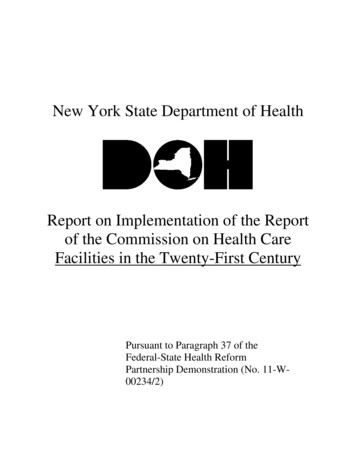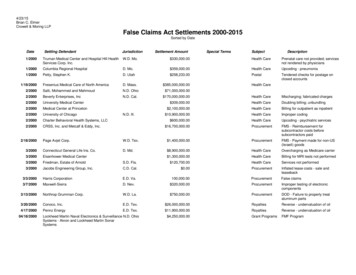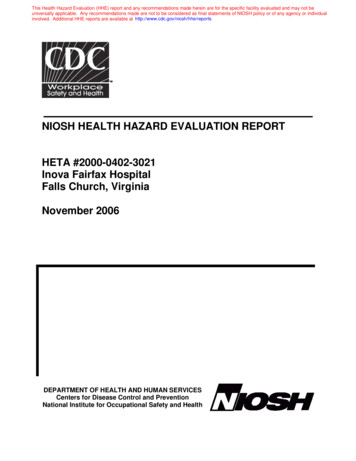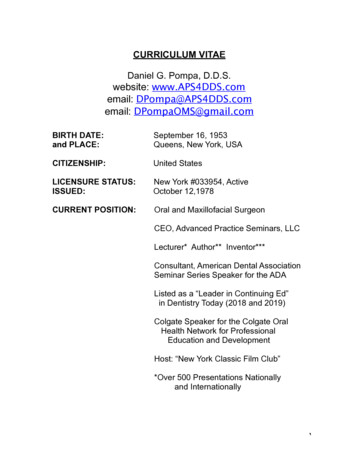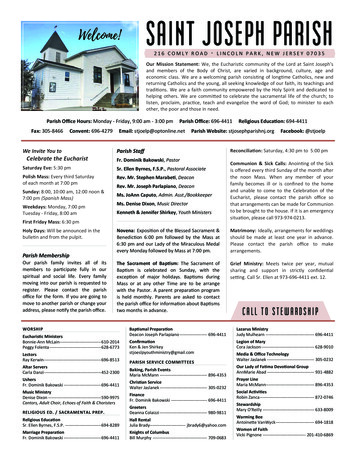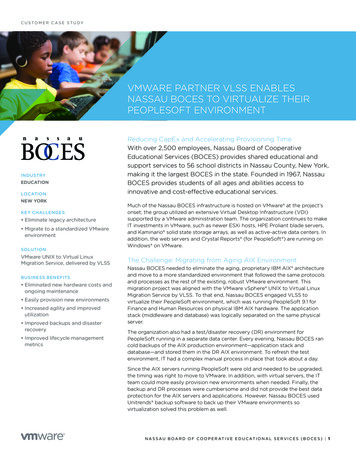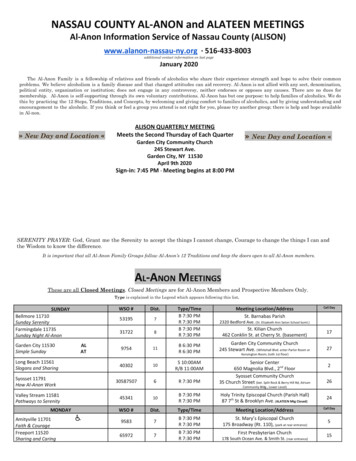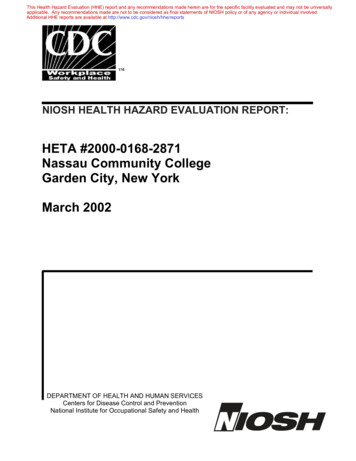
Transcription
ThisThis HealthHealth HazardHazard EvaluationEvaluation (HHE)(HHE) reportreport andand anyany recommendationsrecommendations mademade hereinherein areare forfor thethe specificspecific facilityfacility evaluatedevaluated andand maymay notnot bebe universallyuniversallyapplicable. /www.cdc.gov/niosh/hhe/reportsThis Health Hazard Evaluation (HHE) report and any recommendations made herein are for the specific facility evaluated and may not be universallyapplicable. Any recommendations made are not to be considered as final statements of NIOSH policy or of any agency or individual involved.Additional HHE reports are available at http://www.cdc.gov/niosh/hhe/reportsTMNIOSH HEALTH HAZARD EVALUATION REPORT:HETA #2000-0168-2871Nassau Community CollegeGarden City, New YorkMarch 2002DEPARTMENT OF HEALTH AND HUMAN SERVICESCenters for Disease Control and PreventionNational Institute for Occupational Safety and Health
PREFACEThe National Institute for Occupational Safety and Health (NIOSH) conducts investigations and studies ofpossible health hazards in the workplace. These investigations are conducted under the authority of Section20(a)(6) of the Occupational Safety and Health Act of 1970 (29 USC 669(a)(6)) which authorizes theSecretary of Health and Human Services, following a written request from any employer or authorizedrepresentative of employees, to determine whether any substance normally found in the place of employmenthas potentially toxic effects in such concentrations as used or found.NIOSH also provides, upon request, technical and consultative assistance to Federal, State, and localagencies; labor; industry; and other groups or individuals to control occupational health hazards and toprevent related trauma and disease. Mention of company names or products does not constitute endorsementby NIOSH.ACKNOWLEDGMENTS AND AVAILABILITY OF REPORTThis report was prepared by Patricia L. Schleiff of the Field Studies Branch (FSB), Division of RespiratoryDisease Studies (DRDS). Other DRDS staff involved in the field work were Randy Bolystein, KhaledElsherbini, Amber Harton, Christie Kerrigan, Ju-Hyeong Park, Chris Piacitelli, Jim Taylor, Brian Tift, andDaniel Yereb. The following DRDS staff were involved in the initial site visit: Jean Cox-Ganser and CarolRao. In addition, the DRDS staff who assisted in data management and processing were Barbara Bonnett,Amber Harton, Christie Kerrigan, and Brian Tift; and Michael Attfield and Kathleen Kreiss assisted in thereview process. Medical record review was performed by Eileen Storey. Desktop publishing was performedby Terry Rooney.This report is not copyrighted and may be freely reproduced. Single copies of this report will be availablefor a period of three years from the date of this report. To expedite your request, include a self-addressedmailing label along with your written request to:NIOSH Publications Office4676 Columbia ParkwayCincinnati, Ohio 45226800-356-4674After this time, copies may be purchased from the National Technical Information Service (NTIS) at5825 Port Royal Road, Springfield, Virginia 22161. Information regarding the NTIS stock number may beobtained from the NIOSH Publications Office at the Cincinnati address.For the purpose of informing affected employees, copies of this report shall be posted bythe employer in a prominent place accessible to the employees for a period of 30 calendardays.ii
Highlights of the NIOSH Health Hazard Evaluation at NassauCommunity CollegeNIOSH was asked by the Nassau Community College Federation of Teachers and by the President ofthe college to conduct a health hazard evaluation of respiratory health and indoor air quality at theircampus in Garden City, New York. Health concerns included asthma, chronic sinusitis, hypersensitivitypneumonitis, respiratory infections, and dermatitis among occupants of campus buildings.#What NIOSH Did######Conducted a questionnaire survey of NassauCommunity College full-time employees, focusingon respiratory health.Reviewed medical records of employees.Assessed rooms in campus buildings for waterdamage and mold.Reviewed environmental sampling results andreports from 14 previous indoor air qualityinvestigations.Assessed all this evidence to see if campusbuildings were contributing to chest problems inemployees.What Nassau CommunityCollege Managers Can Do####What NIOSH Found#####Cluster building (A through F) and Libraryemployees reported more chest and nasal/sinussymptoms which improved away from theworkplace than those employees in other surveyedbuildings on campus.Asthma and scarring lung disease was reported onsome medical records.Employees in rooms with water damage or moldhad about twice as many chest complaints asemployees in undamaged rooms.Eighteen percent of employees reported that aphysician had diagnosed them with asthma, incomparison to a state population rate of 10%.CDCCENTERS FOR DISEASE CONTROLAND PREVENTIONNIOSH found relationships between water damageand mold and reported chest symptoms.Based on all the evidence, NIOSH concluded thatbuilding-related factors have led to an excess ofchest complaints at Nassau Community College inthe 1970s buildings.Promptly fix water leaks and replace material thathas been wet for a day or longer.Promptly remove visible mold. Hire a consultingfirm with experience in planning how to removemold, including hidden mold in walls.During construction or renovations, controlexposures to dusts and other contaminants.Involve a local occupational health clinic to help inthe early identification of work-related symptomsand to advise about relocation of affected persons.Disseminate the findings of this report to allfaculty and staff.What Nassau CommunityCollege Employees Can Do###Get chest symptoms evaluated.Get involved in programs that are established tohelp improve the conditions at the college.Report water leaks, visible mold and odor tomanagement.What To Do For More Information:We encourage you to read the full report. Ifyou would like a copy, either ask your healthand safety representative to make you a copyor call 1-800/356-4674 and ask forHETA Report # 2000-0168-2871HE Supplementiii
HETA 2000-0168-2871Nassau Community CollegeGarden City, New YorkPatricia L. Schleiff, MSJu-Hyeong Park, MPH, Sc.DDaniel J. Yereb, MSSUMMARYNassau Community College (NCC), located in Garden City, New York, is the largest two-year communitycollege in the State of New York, employing over 1,200 full time faculty and staff in 40 different buildingson a 225 acre campus. On February 29, 2000, the National Institute for Occupational Safety and Health(NIOSH) received a formal request to conduct a health hazard evaluation (HHE) at the Nassau CommunityCollege. The request, submitted by the Nassau Community College Federation of Teachers (NCCFT), wasconcerned with indoor air quality-related health effects, including asthma, chronic sinusitis, hypersensitivitypneumonitis, respiratory infections, and dermatitis, within eight specified buildings on campus. On March16, 2000, a second request was submitted from the President of NCCFT and the President of NCC amendingthe initial request to include all existing structures on campus. This request followed 20 years of reports andenvironmental investigations at the college of water incursions, relative humidity problems, mold growth, andventilation problems, as well as reported respiratory symptoms. Most of these survey reports focused onenvironmental conditions within the academic buildings built in the late 1970s.On October 23-27 and December 4-8, 2000, NIOSH conducted an environmental assessment of buildingscited in the request using an 'Environmental Assessment Check Sheet' for visual assessment of water stains,visible mold, mold odor, and standing water or moisture in 724 offices and laboratories in 13 buildings. The13 buildings included seven buildings, built in 1978, with a history of water damage and six others built eitherprior to, or after, 1978. On November 20, 2000, NIOSH investigators mailed out health questionnaires onrespiratory symptoms, supplemented with questions concerning demographic information, work historyinformation, cigarette/cigar/pipe smoking habits, physician-diagnosed asthma, and use of latex gloves andsensitivity information, to all faculty and staff within 30 departments on campus. This was followed byattempts to increase participation and to assess respondent bias.The objectives of the investigation were:Cto estimate the prevalence of reported respiratory symptoms, work-related symptoms, and post-hire onsetof symptoms and to determine whether building-related excesses exist;Cto assess the indoor environmental factors relating to potential fungal contamination in the campusbuildings;Cto examine the possible associations between reported work-related respiratory symptoms andenvironmental factors; andCto examine symptom rates among the Nursing Department faculty and staff, especially in relation to theirmove from Cluster F in February 2000.Findings from the environmental assessment showed clear differences between groups of buildings acrossthe campus. Rooms within the Cluster buildings and the Library exhibited distinctly more evidence of waterstains, visible mold, mold odor, and current moisture than any of the other buildings studied. The one newbuilding examined, built in 1992, had the lowest scores for water-damage associated factors, while the olderbuildings, built in 1929, had levels which fell between those for the 1970s buildings and the new building.iv
Of the 393 participants in the questionnaire survey (71% participation), 328 were faculty and 65 were staff.Most were white and never smokers, average age 50 years, with about half being male. Overall, about onethird of the participants reported symptoms of wheezing, chest tightness, shortness of breath, or attacks ofcoughing. About half reported any one of these symptoms. Upper respiratory symptoms, such as nasal andsinus symptoms and throat irritation, and itchy or burning eyes were reported by half to two-thirds of theparticipants overall. Most of the reported symptoms had onset after starting work at NCC, and about half ofthose who reported symptoms noted them to be work-related (either less severe or required less medicationaway from work). Overall, 17% of the participants reported physician-diagnosed asthma, with about half ofthose noting it to be post-hire onset or exacerbated by work. The prevalence of diagnosed asthma reportedby those aged 35-65 years among faculty and staff respondents was 18%, compared to 10% reported overallby New York state residents of that age range.Symptom prevalences by building group showed marked differences. Employees in the 1970s buildings(those with a history of water damage) reported substantially higher prevalences of both lower and upperrespiratory symptoms that were post-hire and work-related. The prevalence of any chest symptoms post-hirewas 44% for the 1970s buildings versus 14% for the older buildings (p-value 0.05) and 21% for the newbuilding (p-value 0.05). Worked-related prevalences were 34, 3 and 19%, respectively (statisticalsignificance for 1970s compared to older buildings, p-value 0.05). Post-hire upper respiratory symptomswere not greatly different across buildings, at 72, 69 and 56%, respectively (statistical significance for 1970scompared to newer building, p-value 0.05). However, the prevalence of work-related upper respiratorysymptoms was higher in the 1970s buildings: 56% compared to 31% for the older buildings (p-value 0.05)and 35% for the newer building (p-value 0.05).To explore the relationship between environmental factors in the rooms and reported symptoms and healthcomplaints, we developed an exposure index based on reported time spent in the rooms and the assessmentsof stains, mold presence and odor, and moisture. Using statistical models that adjusted for employee status(faculty or staff), gender, age, cigarette smoking history, reported allergies, reported use of latex gloves, andthe year of hire, we found clear evidence that symptom reporting was related to factors reflecting waterdamage and its sequelae. Significantly increased odds of having wheeze, chest tightness, shortness of breath,at least one chest symptom, and nasal and sinus symptoms were all related to recorded presence of visiblemold (p-values 0.05). Water stain also was associated with nasal and sinus symptoms and throat irritation(p-value 0.05). Mold odor was associated with throat irritation and any upper respiratory symptoms or eyeirritation (p-value 0.05). Although elevated odds ratios were frequently found for moisture presence, nonewere statistically significant.For participating faculty and staff within the Nursing Department (N 26), 54% reported lower respiratorysymptoms and 73% reported upper respiratory symptoms or eye irritation while they were working in ClusterF. After the Nursing Department moved out of Cluster F in the early months of the year 2000, 36% of thosewho reported having chest symptoms prior to the move reported that their symptoms or breathing problemshad either lessened or disappeared after they moved. This improvement, however, was not reflected in thereporting of upper respiratory symptoms.Overall, the results show high prevalences of lower and upper respiratory symptoms among employees ofNassau Community College, including an excess of asthma compared to state rates. Much of the reportedprevalence was likely work-related, either in terms of post-hire onset or exacerbation at work, and wasconfirmed by evidence from medical records of affected individuals. There were obvious differences in theenvironmental factors across buildings. Reduction in lower respiratory symptoms was observed among asmall subset who moved from the affected buildings. Finally, there was clear evidence of association ofhealth conditions with environmental factors, including higher symptom prevalences in water-damagedbuildings and in association with exposure indices based on factors related to water damage and mold growth.Together, these provide convincing evidence that building-related disease has occurred at Nassau CommunityCollege.We recommend the following for this workplace:1. Promptly fix water leaks and replace material that has been wet for a day or longer. Doing so reduces thepotential for microbial growth.2. Promptly remove visible mold and further evaluate potential hidden mold reservoirs in walls, especiallywithin the classrooms and offices of the 1970s buildings, by obtaining services from a consulting firm withexperience in planning how to remove mold, including hidden mold.v
3. During construction or renovations, use containment measures to control exposures to dusts and othercontaminants.4. Involve a local occupational health clinic to determine whether persons with work-related symptoms inbuildings with previous water damage have building-related conditions that may require relocation. Ongoingmedical consultation and surveillance of the faculty and staff can help set priorities for remediation; preventfurther illness from developing; and reassure employees when the risk decreases. Medical surveillanceactivities may involve repeat questionnaire administration, recording of potential cases seeking evaluation,and medical testing.5. Disseminate the findings of this report to all faculty and staff so that A) they can become more aware oftheir working environment and promptly report any signs of water leaks, visible mold and odors to thephysical plant managers, B) they may seek medical attention if they feel that their symptoms are work-related,and C) they can become involved in programs, such as a medical surveillance program.NIOSH documented that building-related respiratory problems were occurring among employees of NassauCommunity College. Our assessments of environmental contamination showed positive associations withhealth outcomes. Prognosis for work-related asthma is improved by early recognition and exposure cessation.We recommend that medical surveillance be conducted for the early detection of work-related problems, bothfor appropriate clinical management and to show whether remediations have been effective in preventing newcases. Prompt remediation of water incursions and replacement of all wetted material that cannot be driedout in 24 hours should be carried out. During renovations, use containment measures that keep exposuresto dusts and other contaminants of construction at a minimum.Keywords: SIC 8222: indoor air quality, work-related asthma, fungal contaminationvi
TABLE OF CONTENTSPreface . . . . . . . . . . . . . . . . . . . . . . . . . . . . . . . . . . . . . . . . . . . . . . . . . . . . . . . . . . . . . . . . . . . . . . . . . . . . iiAcknowledgments and Availability of Report . . . . . . . . . . . . . . . . . . . . . . . . . . . . . . . . . . . . . . . . . . . . . . iiHighlights . . . . . . . . . . . . . . . . . . . . . . . . . . . . . . . . . . . . . . . . . . . . . . . . . . . . . . . . . . . . . . . . . . . . . . . . . iiiHE Supplement . . . . . . . . . . . . . . . . . . . . . . . . . . . . . . . . . . . . . . . . . . . . . . . . . . . . . . . . . . . . . . . . . . . . . iiiSummary . . . . . . . . . . . . . . . . . . . . . . . . . . . . . . . . . . . . . . . . . . . . . . . . . . . . . . . . . . . . . . . . . . . . . . . . . . ivIntroduction . . . . . . . . . . . . . . . . . . . . . . . . . . . . . . . . . . . . . . . . . . . . . . . . . . . . . . . . . . . . . . . . . . . . . . . . 1Background . . . . . . . . . . . . . . . . . . . . . . . . . . . . . . . . . . . . . . . . . . . . . . . . . . . . . . . . . . . . . . . . . . . . . . . . 2Methods . . . . . . . . . . . . . . . . . . . . . . . . . . . . . . . . . . . . . . . . . . . . . . . . . . . . . . . . . . . . . . . . . . . . . . . . . . . 4Results . . . . . . . . . . . . . . . . . . . . . . . . . . . . . . . . . . . . . . . . . . . . . . . . . . . . . . . . . . . . . . . . . . . . . . . . . . . . 7Discussion . . . . . . . . . . . . . . . . . . . . . . . . . . . . . . . . . . . . . . . . . . . . . . . . . . . . . . . . . . . . . . . . . . . . . . . . 12Recommendations . . . . . . . . . . . . . . . . . . . . . . . . . . . . . . . . . . . . . . . . . . . . . . . . . . . . . . . . . . . . . . . . . . 15References . . . . . . . . . . . . . . . . . . . . . . . . . . . . . . . . . . . . . . . . . . . . . . . . . . . . . . . . . . . . . . . . . . . . . . . . 16Tables and Figures . . . . . . . . . . . . . . . . . . . . . . . . . . . . . . . . . . . . . . . . . . . . . . . . . . . . . . . . . . . . . . . . . . 18Appendix A: Current Assessment Sheet . . . . . . . . . . . . . . . . . . . . . . . . . . . . . . . . . . . . . . . . . . . . . . . . 36Appendix B: Health Questionnaire . . . . . . . . . . . . . . . . . . . . . . . . . . . . . . . . . . . . . . . . . . . . . . . . . . . . 37Appendix C: Non-respondent Survey . . . . . . . . . . . . . . . . . . . . . . . . . . . . . . . . . . . . . . . . . . . . . . . . . . 53Appendix D: Participants not Selected for the Main Study . . . . . . . . . . . . . . . . . . . . . . . . . . . . . . . . . . 55
INTRODUCTIONpart-time) within 30 departments in twelvecampus buildings.On February 29, 2000, the National Institute forOccupational Safety and Health (NIOSH) receiveda formal request to conduct a health hazardevaluation (HHE) at the Nassau CommunityCollege (NCC) in Garden City, New York. Therequest, submitted by the Nassau CommunityCollege Federation of Teachers (NCCFT) wasconcerned with indoor air quality related healtheffects, including asthma, chronic sinusitis,hypersensitivity pneumonitis, respiratoryinfections, and dermatitis within eight specifiedbuildings on campus. On March 16, 2000, asecond request was submitted from the Presidentof NCCFT and the President of NCC amendingthe initial request to include all existing structureson campus. From April 2 through April 5, 2000,NIOSH investigators conducted an initialinvestigation of the environmental conditions andhealth concerns. The investigation consisted of awalk-through of certain campus buildings cited inthe request, preliminary examination of existingventilation systems and other buildingcharacteristics, and review of maintenance andhealth complaint records.On December 4 through December 8, 2000, asecond industrial hygiene survey was conducted tofinish the qualitative environmental assessmentwithin classrooms, laboratories, and offices ofCluster F, the Library, Buildings G, H, V, Z, andNassau Hall. Buildings X and Q were alsoinvestigated per the request of some employees.One hundred and ninety-eight rooms wereinvestigated during the follow-up, bringing thetotal number of rooms investigated to 725.Building materials with suspected fungal growthand photographs of some environmentalconditions were also collected.NIOSH field investigators conducted an industrialhygiene survey from October 23 through October27, 2000, to assess qualitatively the indoorenvironment for dampness and potential biologicalcontamination within all classrooms, laboratories,and offices of Clusters A, B, C, D, E, and F, andthe Library. Five hundred and thirty-five roomswere investigated. In addition to conducting thisenvironmental assessment, building materials withsuspected fungal growth were collected,photographs were taken of some of theenvironmental conditions, and in-wallexaminations were performed in several roomsusing a boroscope and monitor to inspect theinside of the wall cavity.On November 14, 2000, a NIOSH investigatordiscussed with NCCFT representatives and NCCAdministration the planning stages for aquestionnaire survey of employees within twelveselected buildings on campus. This included theeight specified buildings in the initial request,which were all Cluster buildings (A, B, C, D, E,and F), the Library, and Building G, and fouradditional buildings (Buildings H, V, Z, andNassau Hall or Building M) that we observedduring the initial investigation. A pilot test of thehealth questionnaire was conducted with membersfrom NCCFT. On November 20, 2000, NIOSHinvestigators mailed out 1570 healthquestionnaires to all employees (full-time andHealth Hazard Evaluation Report No. 2000-0168-2871In addition to the environmental assessments fromDecember 4 through December 8, 2000, healthquestionnaires were collected from participatingemployees within the twelve selected buildings.On December 13, 2000, a second set ofquestionnaires was mailed to approximately 300full-time faculty and staff who did not return theirquestionnaire in early December. Part-timeemployees were not included in this mailingbecause of their low initial participation rate.Around the same time, in the interest of includingother interested faculty and staff, the college sentNIOSH questionnaires to all faculty and staff oncampus not included in the initial NIOSH mailing.Questionnaires were mailed back to NIOSH, andthe collection of questionnaires continued untilMarch 30, 2001.On April 23 through April 27, 2001, a telephonesurvey was conducted to collect healthinformation from the non-respondent populationof 161 full-time faculty and staff.On February 7, 2000, an interim letter was sent tothe college summarizing some of theenvironmental information collected during theNIOSH site visits in October and December, 2000.This letter contained information about thedistribution of rooms investigated with the‘Environmental Assessment Check Sheet’ and anupdate on the collection of health questionnaires.On March 5, 2000, a second interim letter wassent to the college summarizing the microscopicverification of potential fungal contamination ofsamples of building material collected during theenvironmental investigations.This report presents the results from the healthquestionnaire and environmental assessmentsurveys, a summary of the medical records thatNIOSH received from faculty and staff at thecollege, and recommendations for improvingPage 1
indoor environmental quality and reducingemployee symptoms.BACKGROUNDHISTORYNassau is the largest two-year community collegein the State of New York. It was created in 1959as part of the State University of New York(SUNY) system. The first classes at the collegebegan in the early 1960's when it was located inthe Old County Courthouse in Mineola, NewYork. In 1962, classes moved to the formerUnited States air base at Mitchel Field in GardenCity, New York, because of the increase in studentenrollment. In the Fall semester 2000, over20,000 students had enrolled in more than 30academic departments and participated incontinuing education and special programs forbusinesses. Approximately 1231 full-timeemployees, including 630 full-time faculty, wereemployed at the college. There was a total ofsome 3000 employees, including about 400adjunct faculty and 700 students hired as part-timeaides.CAMPUS BUILDINGSThere are approximately 40 academic andadministrative buildings located on the campus,which covers more than 225 acres of land. Someof the buildings (e.g., Buildings H, V, Z, NassauHall, North Hall, Bradley Hall) were built in thelate 1920s through the early 1940s. Others, suchas the Library, Physical Education Complex,Administrative Tower, and two academic wings(Clusters A-D and E-F), were built in the late1970s. In 1992, the college built the SocialSciences and Visual Arts building (i.e., BuildingG) and the Student College Center. The buildingson campus are different by structure, purpose,occupant density, and ventilation systems.The older buildings are refurbished formermilitary buildings (e.g., hospital, barracks,hangars, Continental Air Command headquarters,1st Bomber Command headquarters, BachelorOfficers quarters) and former military homes.Classrooms, laboratories, faculty offices, andadministrative offices are located generally on twofloors within these buildings. Originally, some ofthese buildings were wood structures.Reconstruction of some of the older buildingsbegan in the early 1930s, where wood structureswere replaced with brick structures. Mostoccupied spaces have operable windows. ThePage 2heating and cooling systems consist of waterradiators, heat pumps, and air-conditioningwindow units. The floors are mostly tiled, butsome offices have carpet. All interior walls aresheet-rock material.In 1975, construction began on six academicbuildings, known as the Cluster buildings Athrough F. Construction of these buildings haltedbecause of financial reasons, and these buildingsremained exposed to the outside environment forabout 5 years. By 1978, the Cluster buildingswere completed. These buildings are precastconcrete structures with flat roofs. They have threefloors of classrooms and laboratories, except forCluster D which has only two floors oflaboratories and faculty offices. The offices arelocated in long corridors that are attached toclassroom ‘pods’. These buildings have windowsthat can not be opened. The heating and coolingventilation systems are unit ventilators locatedunder windows. These units, when operating,bring outside supply air (about 25%) over a hotwater pipe during the winter seasons and a chilledwater pipe during the summer seasons. Air intakevents are within 6 inches of the ground.Historically, this area was a prime nesting spot forpigeons. A pigeon control program was put intoplace in the early 1980's, and the number ofnesting pigeons has decreased. A central airhandling unit, which is located on the roof of eachof these buildings, supplies conditioned air to theinterior sections of the building, such as hallways,elevator areas, classrooms, and laboratories, via airdiffusers. All laboratories have exhaust hoods.The floors are tiled throughout the classrooms andlaboratories, and only the offices are carpeted.Interior walls that touch exterior concrete slabs aremetal wallboards. All other interior walls aresheet-rock material.The library was also built in the late 1970s and hasexactly the same interior and exterior structure asthe Cluster buildings. There are three floors, allcarpeted, and windows that can not be opened.The heating and cooling ventilation system is verysimilar to that in the Cluster buildings.The Social Sciences and Visual Arts building isone of the newest buildings on campus. Theexterior of the building is brick and the interiorsurfaces are sheet-rock material. There are threefloors of classrooms, laboratories, and facultyoffices. All occupied spaces have operablewindows. The heating and cooling systemconsists of heat pumps and air-conditioningwindow units. The floors are tiled throughout thebuilding, except for the offices, which have carpet.Health Hazard Evaluation Report No. 2000-0168-2871
HISTORICAL ENVIRONMENTALINFORMATIONSince the early 1980s, there have been reports atthe college of water incursions, relative humidityproblems, mold growth, and ventilation problems,as well as reported respiratory symptoms. At leastfifteen independent environmental consultinggroups have evaluated building conditions since1982. Most of these survey reports focused onenvironmental conditions within the academicbuildings built in the late 1970s, i.e., Clusterbuildings (A-F) and the Library.Typicalrecommendations from these environmentalreports were for the proper functioning andmaintenance of the ventilation systems; the properstorage of chemicals used in the laboratories;repairing moisture sources, such as roofs andpipes; replacing the water-damaged materials,such as ceiling tiles, car
Nassau Community College (NCC), located in Garden City, New York, is the largest two-year community college in the State of New York, employing over 1, 200 full time faculty and staff in 40 different buildings on a 225 acre campus. On February 29, 2000, the National Institute for Occupational Safety and Health (NIOSH) received a formal request .
